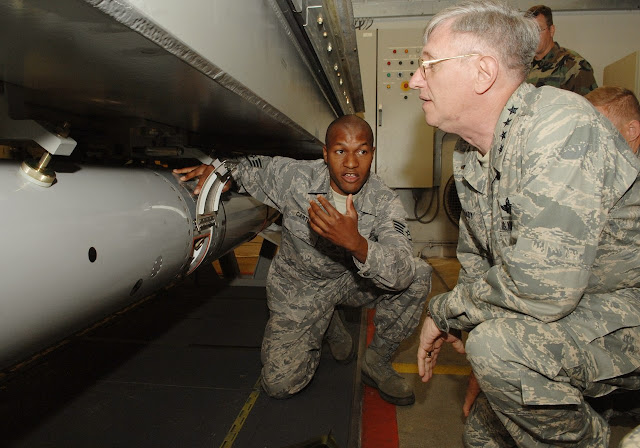This it noting the rapidly
rising military threat to Australia from nuclear armed China has led to the US's and UK's unprecedented offer of nuclear propelled submarines for Australia. Increasingly aggressive Russia also has a nuclear armed Pacific Fleet. For the medium-long term the US should be persuaded to apply its NATO Nuclear
Sharing approach to Australia as a deterrent under AUKUS.
This need not await the operation of Australian SSNs in the 2040s. Under AUKUS Australia is joint researching land and air launched hypersonic missiles with the US and UK. These could mount nuclear shared warheads in the 2030s. Australia and US NASA just happen to be developing ever longer range rocket boosters with ever larger payloads.
The following is to
familiarize readers with the long-term-still current NATO nuclear sharing
reality. Wiki advises:
"Nuclear sharing is a concept in NATO's
policy of nuclear deterrence,
which allows member countries without nuclear weapons of their own to
participate in the planning for the use of nuclear weapons by NATO. In
particular, it provides for the armed forces of those countries to be
involved in delivering nuclear weapons in the event of their use.
As part of nuclear sharing, the participating
countries carry out consultations and make common decisions on nuclear weapons
policy, maintain technical equipment (notably nuclear-capable airplanes)
required for the use of nuclear weapons and store nuclear weapons on their
territory. In case of war, the United States told NATO allies the Non-Proliferation Treaty (NPT) would no
longer be controlling.[1]
Of the three nuclear powers in NATO (France, the United Kingdom and the United States), only the United States is known to have provided weapons for nuclear sharing. As of November 2009, Belgium, Germany, Italy, the Netherlands and Turkey are hosting U.S. nuclear weapons as part of NATO's nuclear sharing policy.[3][4] Canada hosted weapons under the control of the North American Aerospace Defense Command (NORAD), rather than NATO, until 1984, and Greece until 2001.[3][5][6] The United Kingdom also received U.S. tactical nuclear weapons such as nuclear artillery and Lance missiles until 1992, even though the UK is a nuclear-weapon state in its own right; these were mainly deployed in Germany.
|
Weapons provided for nuclear sharing (2021)[2] |
||
|
Country |
Base |
Estimated |
|
20 |
||
|
20 |
||
|
20 |
||
|
20 |
||
|
20 |
||
|
100 |
||
In peacetime, the nuclear weapons stored in non-nuclear countries are guarded by United States Air Force (USAF) personnel and previously, some nuclear artillery and missile systems were guarded by United States Army (USA) personnel; the Permissive Action Link codes required for arming them remain under American control.
In case of war, the weapons are to be mounted on the participating
countries' warplanes. The weapons are under custody and control of USAF
Munitions Support Squadrons co-located on NATO main operating bases who work
together with the host nation forces.[3]
As of 2021, 100 tactical B61 nuclear bombs are believed to be deployed in Europe under the nuclear sharing arrangement.[2] The weapons are stored within a vault in hardened aircraft shelters, using the USAF WS3 Weapon Storage and Security System. The delivery warplanes used are F-16s and Panavia Tornados.[7]"
Pete Comment
For Australia, delivery platforms could begin with 1 to 3 MIRVs MRBMs (boosters large enough are being developed) and our air-to-air refueled F-35As.

6 comments:
Pete
I agree in the medium term this is an obvious strategy for Australia and all Indo Pacific NATO partner states to adopt. As in Germany it avoids a lot of domestic sensitivity.
However I think it would be a big mistake to raise it now. Australia needs to get the SSN deal through the NNPT first, and this sort of potential is precisely the sort of risk opponents might use against Australia’s case.
Hi Anonymous
I am but a simple blogger ignored by the Aussie Gov and presumably by the IAEA.
Somewhat like the "Old Man and the Sea" *
In mine honesty.
Luckily attention from the US Gov has been more evident.
I state categorically no connection to any Tube Alloys Planning Committee in Canberra.
* https://en.wikipedia.org/wiki/The_Old_Man_and_the_Sea#Plot_summary
Your Obediant Servant Pete
Hi Pete,
Small correction, that is not James Mattis in the picture, that is General Roger Alan Brady USAF. The USAF uniform gives this away as Mattis was a US Marine.
Thanks Anonymous [at Jul 14, 2022, 7:33:00 PM ]
Mattis gone, Brady of the 3 or 4 jobs is in.
Cheers Pete
Interesting to note that, although the current iteration of the Tomahawk Block V SSM has a conventional warhead, other things are possible.
The US nuclear warhead weights 180kg, compared to a Tomahawk warhead payload of 450kg. So it would still be possible to equip Tomahawk with a nuke.
The French SCALP SSM has a 400kg warhead and the future MdCN will be similar.
So all of the western SSN operators have access to a 1000km range cruise missile that can be launched from torpedo tubes and could be nuclear armed.
Hi Anonymous [at Jul 21, 2022, 11:38:00 AM]
Nuclear tipped Tomahawks have existed over the years but, maybe for the best, the US has recently decided SLCMs including Tomahawks should not be nuclear armed.
https://news.usni.org/2022/04/27/report-to-congress-on-sea-launched-nuclear-cruise-missile
Reasons include (re)development cost and existence of low yield Trident II SLBMs.
A major risk of having SLCM-Ns (for nuclear) is warhead ambigity in which SLCM-Ns would increase the likelihood of China, N Korea or Russia being unsure whether an SLCM fired at their territory by an SSK, SSN or SSGN, deserves a nuclear response.
So ballistic nuclear missiles only for SSBNs are safer.
That said, warhead ambiguity for a wide range of emerging hypersonic missiles is a whole new dangerous ball game.
Regards Pete
Post a Comment